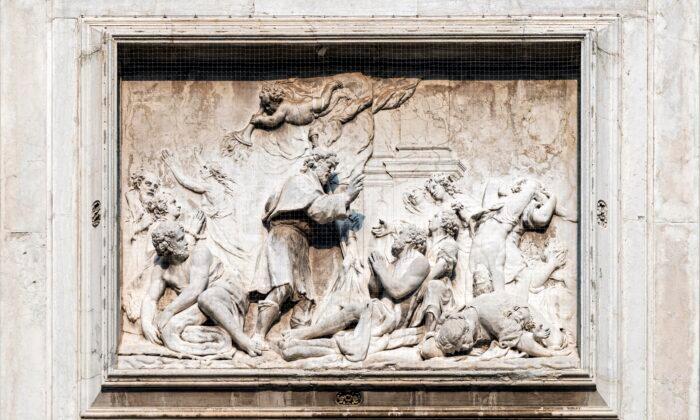We have lived through a time of contagion, quarantine, confinement, an invisible enemy, an epicenter of the disease, flight from contaminated towns and cities, the closure of public places, the punishment of the imprudent breakers of regulations, medical controversies, a multiplication of cures, the flourishing of rumors, the disruption of funerary ceremonies, the fear of strangers, tensions under lockdown, closed churches, increased intrafamilial violence, threats against those who illicitly frequent the ill, times of abnegation, solidarity, generosity, and sacrifice, as well as cowardice and selfishness
I am sure that by now everyone will have realized that I am speaking of the epidemic of plague in Marseille and Provence in 1720, which lasted (in some places) until 1722.
Of course, there were differences from our recent experience and present situation: the epidemic is thought to have killed nearly a third of the population of the region, about 120,000 of 390,000 inhabitants.
In present-day terms, that would mean the deaths of more than 2,000,000,000 people worldwide, rather than the 1,000,000 killed by Covid-19 so far. Brought to Marseille from what used to be called the Levant, the plague in 1720 failed, unlike the Black Death of 1346–1349, to spread to the rest of the Europe.
Naturally, people in those days were as determined to try remedies as we are today, whether or not they worked: for very few people are prepared to admit that there is nothing, at least for the moment, to be done, either for themselves or for others. Therapeutic nihilism does not come easily to Man.
Here is one recipe for a cure (if you are eating breakfast or any other meal, or even if you have just eaten one, I advise you to skip the rest of this paragraph), the advice given to the people of the town of La Valette: “When you have fever, crush forty to fifty snails, the biggest are the best, with their shells; and apply such a number to the soles of each foot and leave them for 24 hours… You must apply them as a plaster… During this time, you feel as if you have been pricked by needles in several parts of your body. After the 24 hours have passed, you must remove the first plaster, throw it away at a distance or bury it, if possible deeply; then crush ten or twelve more snails, and apply them for another 24 hours.”
This cure appeals to a deep strain of pessimism in the human soul: if a remedy is sufficiently unpleasant or nauseating, it must do good. Of course, unless snails were a good deal more common then than they are now, it cannot have been easy to have found fifty large snails, especially if many other people were looking for them too, but difficulty of procurement is another powerful stimulant to the placebo effect.
If something is rare and not easily available to others, it does you more good than if any Tom, Dick, or Harry can find it without difficulty.
There is, it is also true, no theoretical reason why it should, but the history of medicine is replete with discoveries made quite by chance and without any scientific theory to justify them.
Human Nature
When one reads of the epidemic in Marseille and Provence, one realizes that human nature does not change very much.Here is the priest, Jean Félix Blanc of Toulon, writing to his friend in Paris, Chevalier de Ricard, in November, 1721, immediately after the relaxation of the equivalent of the lockdown, during which the townspeople who had not fled to the countryside à la New York bourgeoisie in 2020, “kept themselves confined in their houses and did not leave except under pressing need,” when most of the shops and all the churches were closed.
“The churches here opened on the eve of All Soul’s Day with all solemnity. Everyone took communion without the slightest care and we have already begun to forget that we ever had plague.”
We don’t congregate in churches today, of course,: instead, we worship in bars and restaurants. But certainly it doesn’t take us long, at least for the young among us (and most people in the early eighteenth century were young), to forget that there ever was an epidemic.
During the plague, the municipalities had to borrow money hand over fist, just like governments today. The council of the town of Martigues, population 15,000, wrote to the government requesting funds: “About 2000 inhabitants will have to be assisted by the town, notably the sailors who cannot work because there are 100 ships, not counting all the little boats, which are tied up in the port, not being able to put to sea to trade or fish, because all other ports are closed to them. Other than that, we have four infirmaries in which we take the town’s sick to prevent the spread of contagion, three for the currently sick and one for the convalescents, and in these infirmaries we have doctors, surgeons and apothecaries, in all more that 250 people, without counting all those, a considerable number, who have to stay at home for lack of space in the infirmaries. In addition we have 120 militia men under arms at 30 pounds per month, without counting the higher paid officers, to keep people in order and avoid sedition. We have also employed people to carry people to the mass graves where they are buried.”
The parallels with our present predicament are not exact however. The towns’ public debts occasioned by the plague in the early Eighteenth Century were repaid within ten years: while our debts will be extinguished, if ever, only by inflation or by default. So there has been progress after all.
NOTE: I should like to acknowledge Prof. Gilbert Buti’s fine book, “Colère de Dieu, mémoire des hommes: La peste en Provence, 1720 -2020,” Éditions du Cerf, 2020, from which I have gathered my information.






Friends Read Free